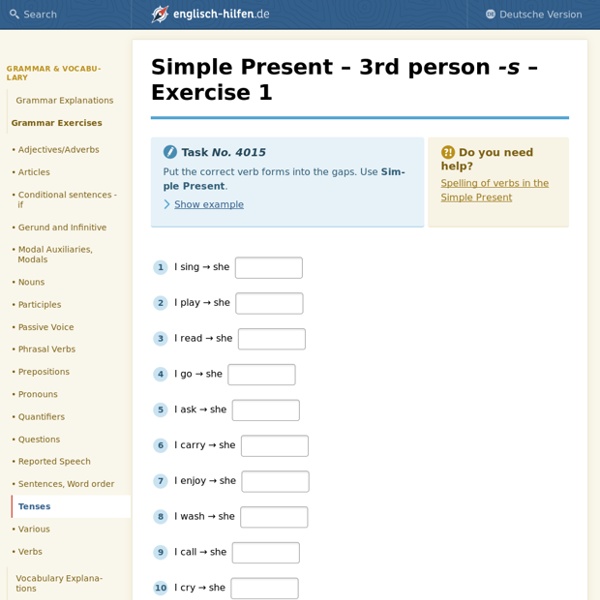Simple Present - 3rd person -s in Singular
To keep this offer free of charge, we and our partners (233) need your consent. This includes the use of a so-called "TC String" – a digital identifier that stores your advertising preferences and enables the compliance with your data protection preferences. This allows the use of cookies and similar technologies, thus enabling us to display advertising tailored to your interests based on your user behavior. Here, you can also revoke your consent at any time with effect for the future. Note on data transfer to the USA: Data transfer to the USA is only carried out within the framework of legal possibilities.
https://www.englisch-hilfen.de/en/exercises/tenses/simple_present_s.htm
Related: Language and grammar
Simple Present Exercises
Simple Present Exercises Jump to Simple Present Explanation Practice with these Simple Present exercises: Simple Present Exercise 01
Coherencia y cohesión en el discurso académico Ejercicio de Inglés
La coherencia y la cohesión son dos características esenciales del discurso académico. Por coherencia (coherence) entendemos la existencia de un hilo conductor que vincula todos los argumentos o las ideas que constituyen el texto. Por ejemplo, en un texto argumentativo, los argumentos que constituyen el cuerpo del texto están relacionados con la tesis expuesta en la introducción (más detalles en la lección Como escribir un texto argumentativo en inglés. La coherencia del texto se manifesta, entre otros, en la repetición de palabras clave y el uso de sinónimos para evitar redundancias. La cohesión de un texto (cohesion) es una característica de la forma y no tanto del contenido del texto. Se trata de los medios lingüísticos que se utilizan en un texto para establecer relaciones lógicas entre ideas y/o partes del texto.
Lanternfish ESL: Lesson for Adult Classes
The Odd One Out Game: Students look at a list of four items and decide which is different. They must give a reason. Everybody holds their answer up at the same time. If their reason is unique they get a point. Example: Eagle, Owl, Bat, Penguin.
First conditional – grammar explanation for learners of English
First conditional is very similar to time clauses. However, I would say that first conditional is easier than time clauses. First conditional is used if we speak about two possibilities in the future.
How to teach second conditional
Conditionals scare students to death. They seem complicated and difficult to understand. But as I explain, they only seem to be like this. In fact, they are quite simple and easy to comprehend. In this post I will try to keep things as simple as possible. I will deal only with one type of conditional – the second conditional.
How to Form and Use the Third Conditional
The third conditional is the most feared grammar point I know. Students of English think that it’s hard to form and understand. Therefore, when they start learning the grammar they are paralysed with fear. And as a result, they fail to learn it.
Use six different tenses in English
Students often learn just one piece of grammar in a lesson. Most of them master that day’s subject and move on to the next. But, when the time for revision comes, they often don’t remember what they’ve learnt. For example, two weeks ago my class encountered an exercise in which several tenses were revised. First, they demanded that I re-explain the grammar and then they seemed really confused about what form they should use.
Formación de palabras para el Use of English del First de Cambridge
Rox| 7 min de lectura Boring? Bored?
Future Tenses - Exercises - Lingolia English
display incorrect answers Choose the correct verbs, using each tense once.Future I (will or going to), future II, simple present or present progressive The train at 11:20.time set by a train schedule → simple presentWait! I you.spontaneous decision → future I (will)As we want to get better marks in English, we harder in the future.planned action for the future → future I (going to)Josh to the cinema with his friends tonight.set appointment in the near future → present progressiveI am afraid they everything by the time we arrive.action that will have been completed by a certain point in the future → future II
Reported Speech Practice: Pre-Intermediate Level
Use reported speech to tell someone what another person said e.g. Jack told me he played tennis. If the reporting verb is in the past, the reported clause is in a past form.This form is usually one step back into the past from the original, eg.
Active & Passive Voice - Scholarly Voice - Academic Guides at Walden University
The APA 6th Edition, Section 3.18, indicates that writers should use the active voice for clarity (APA, 2010, p. 77). Writing in the active voice means the subject of the sentence clearly performs the action that the verb expresses. APA stresses using the active voice to make it clear to the reader who is taking action in the sentence.
Related:



